Content
Every gardener dreams of a beautiful plot. Of the majority of ornamental plants, barberry is very popular.... There are many varieties of this shrub. One of the most unusual and colorful varieties is the tunberg atropurpurea barberry.
Description of barberry varieties Thunberg atropurpurea
Tunberg barberry atropurpurea is a very beautiful and unusual shrub that is grown to decorate the garden or as a hedge.
Unfortunately, barberry fruits of this variety are not eaten, they have a lot of alkaloids, which is why they are bitter and not tasty. They ripen at the end of October and are red, small and oblong berries that literally shower over the shrub. Due to its appearance, barberry often attracts the attention of birds, which helps, to some extent, protect other fruit and berry plantations.
 Barberry bush Thunberg Atropurpurea with berries
Barberry bush Thunberg Atropurpurea with berries
By the age of 5, the shrub grows up to 2 meters in height and 3.5 in width. The dwarf form of barberry Atropurpurea is called Thunberg Atropurpurea nana. Popularly, the variety of barberry tunberg atropurpurea is called red-leaved barberry, which is due to the unusual color of the leaves. In summer they are purple, in autumn the color becomes more saturated and turns into a bright red. Green spots appear on the leaves in the shade, therefore, in order to preserve the decorative appearance of the barberry, it is better to plant it in sunny places.
Flowering falls on 2-3 weeks of May... The flowers are round in shape, grow in diameter only up to 1 centimeter, usually they are collected in brushes of 3-6 pieces. The inside of the flowers is bright yellow and the outside is purple-red.
The mountains of the Caucasus and the southern regions are considered the natural habitat of the shrub, but its frost resistance allows growing in colder areas.
The life cycle of this plant is 50-60 years.
Growing conditions
Red-leaved barberry has good winter hardiness, and it can be grown in almost any area... It is also necessary to note the endurance of this plant in front of sunlight, it is not afraid of not only frost, but also heat.
The only condition that must be met during planting is sensitivity to soil moisture, it should not be dry, but the presence of nearby groundwater can cause rotting of the root system.
Advantages and disadvantages
The only drawback of the barberry tunberg atropurpurea is the taste of the fruit, they are not suitable for consumption, and therefore such a shrub is suitable for growing only as an ornamental plant.
 Barberry Thunberg Atropurpurea will decorate any personal plot
Barberry Thunberg Atropurpurea will decorate any personal plot
There are many more advantages of this variety.:
- excellent and unusual appearance, the bright color of the leaves and the wide crown are well suited for creating a hedge;
- bush not afraid of winter cold;
- longevity;
- grade not picky about care and growing conditions, tolerates heat, drought, etc .;
- bright berries allow you to distract the attention of birdsthus protecting other plants.
Landing rules
There are several rules, observing which the barberry shrub will decorate the garden plot for a very long time. First you need to decide on a place, it must meet the following requirements:
- necessarily the presence of a lot of sunlight, shading can cause discoloration of the leaves;
- although barberry loves moisture, its excess can destroy the plant, therefore lowlands should be avoided and places where precipitation and melted snow accumulate;
- also you can not plant barberry in places high water table.
The gardener must take into account the diameter of the crown of the shrub and place it at a distance of at least 4 meters from other plantings.
It is also necessary to prepare the soil in advance. If planting is carried out in the spring, then the soil is prepared in the fall, and in the case of autumn planting 3-4 weeks before work:
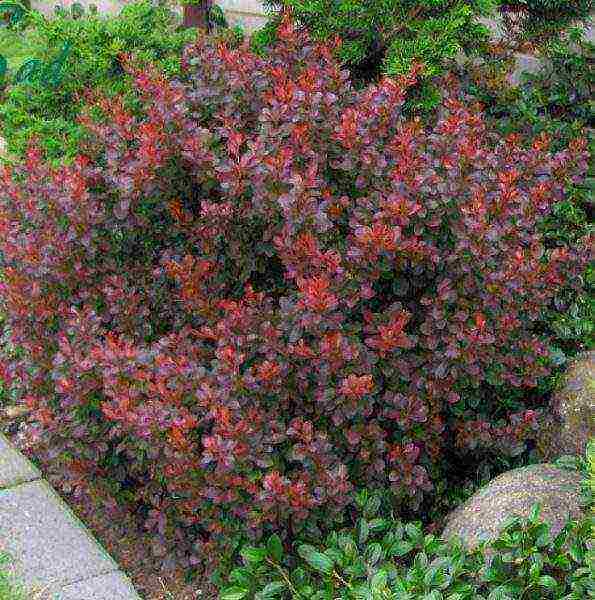 When choosing a place for planting, it should be borne in mind that a large amount of sunlight is needed for the Thunberg Atropurpurea barberry
When choosing a place for planting, it should be borne in mind that a large amount of sunlight is needed for the Thunberg Atropurpurea barberry
- High acidity is not allowed, therefore, if this indicator is available, it is necessary to add lime or dolomite flour;
- Loamy or chernozem soil you need "Lighten" with peat or sand;
- Pit size depends on the age of the plant:
- up to 2 years diameter and depth are equal 25-30 centimeters;
- for aged shrubs up to 3 years the dimensions of the pit will be 50x50 centimeters.
If the barberry is planted as a hedge, it is necessary to dig a trench with a width and depth of 40 centimeters.
- While digging a hole, the upper the fertile soil layer is mixed with:
- 2 buckets of compost or humus;
- 2 buckets of sand;
- 100 grams of superphosphate.
The best time to plant it is considered the beginning of spring, but work can also be done in mid-October.
Before planting, the soil must be thoroughly moistened, and additionally watered after the seedling is in the ground. It is also recommended to mulch the soil.
Care
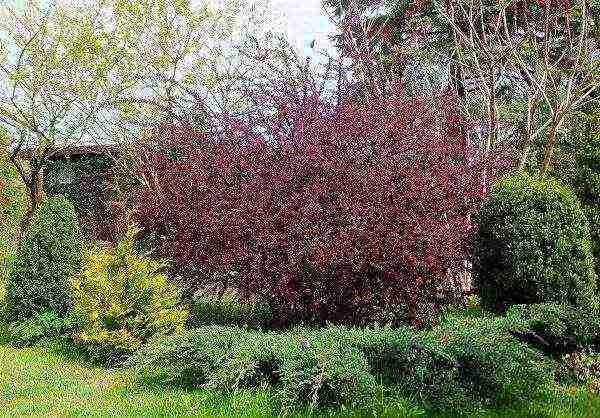 Watering adult barberry bushes Thunberg Atropurpurea can be 2-3 times a month
Watering adult barberry bushes Thunberg Atropurpurea can be 2-3 times a month
Like any other plant, barberry needs care. An adult shrub is not whimsical to the frequency of watering, you can moisten the soil 2-3 times a month, the main thing is not to allow drying out. The young barberry, which is just adapting to a new habitat, requires much more moisture, it is watered 1-2 times a week.
Barberry is very picky about the amount of oxygen in the soil, so you need to loosen the ground around the shrub as often as possible. Removing weeds and other plants is also considered an important step.
After watering and weeding the root zone, it is recommended to cover it with a 5-7 cm layer of mulch from sawdust, peat or other material. This procedure will help to retain moisture and oxygen for as long as possible.
Top dressing
One of the most important stages of growing a shrub is proper feeding. Although it is believed that barberry tunberg atropurpurea is not picky about the quality of the soil, when it is saturated, the shrub will look much more powerful and beautiful.
| In the spring, the next year after planting, in the future, this procedure is repeated once every 4 years. | A young plant is watered with 30 grams of urea, diluted in 10 liters of water. As the shrub grows, 1 bucket of fertilizer will be consumed per 1 square meter of the root zone. |
| Before and after flowering | For one adult shrub, prepare the following mixture:
|
| In late autumn, after leaf fall | Mineral fertilizers are needed to prepare the plant for winter. 15 grams of superphosphate and 10 grams of potassium sulphide are poured under one bush.If the weather is rainy, then the fertilizers are left dry, but if precipitation is not expected, it is best to water the plants so that the fertilizing dissolves. |
An adult barberry does not need a winter shelter, but a young and fragile shrub can die due to severe frost. Therefore, experienced gardeners recommend cover plants with burlap for the winter until the age of 4-5 years.
Pruning
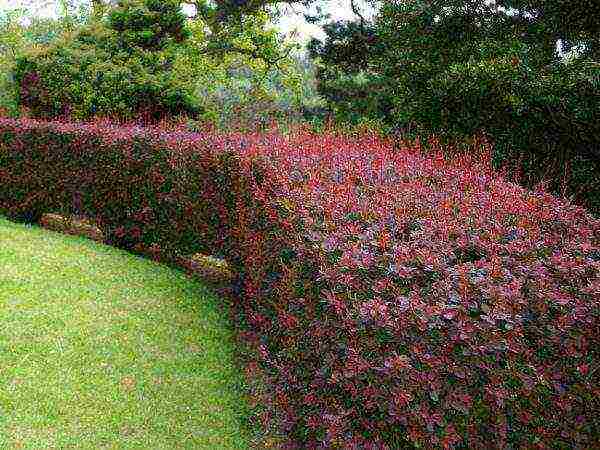 Barberry Thunberg Atropurpurea is used for hedges
Barberry Thunberg Atropurpurea is used for hedges
Thunberg barberry atropurpurea is grown as a decorative element, therefore, in early spring, while the plant is at rest, it needs to be given the desired shape, the choice of which depends on the wishes of the gardener. Usually, such a shrub is shaped into a ball. Barberry growing as a hedge is cut to the desired height.
Also, the shrub needs sanitary pruning, it is carried out in early spring and late autumn. The purpose of such work is to remove dry, frozen or damaged branches.
Diseases and pests
Barberry is resistant to many diseases and pests, but still gardeners may face the following problems:
| You can get rid of these diseases by treating the shrub with modern chemicals or 1 percent solution of colloidal sulfur. |
| Plant treatment with 1 or 3% chlorophos solution. |
| A solution helps well, during the preparation of which 150 grams of laundry soap is diluted in 5 liters of water. |
Reviews
Olga: my mother began to grow red-leaved barberry, and since that time, a bright hedge has flaunted on our site. Our bushes are over 30 years old, of course I cut them every year, but they look just great. This is ideal for the lazy gardener.
Victor: I read somewhere that barberry berries attract the attention of birds, I decided to plant and did not regret, in addition to the distracting effect that I wanted to achieve, I got a beautiful and unusual plant on my site that pleases the eye and attracts the attention of neighbors.
Anastasia: decided to start landscaping the garden, a friend of the landscape designer advised the barberry tunberg atropurpurea, planted it and did not regret her choice at all. The shrub is lush and beautiful, fits perfectly into any decorative composition.
 Barberry Thunberg Atropurpurea in the garden
Barberry Thunberg Atropurpurea in the garden
Thunberg barberry atropurpurea will be an excellent element of any landscape design... In addition, such a plant does not require special attention to itself and even an inexperienced gardener can handle the cultivation.
 Barberry Thunberg from the position of planting a shrub in its own garden is a very unpretentious and grateful plant to care for: barberry is not afraid of summer heat and drought, it tolerates winter well, grows on poor soils. It can serve as a decorative live thorny hedge from uninvited guests. Homemade preparations are made from berries: jam, marshmallow, compote, marinade, liqueurs.
Barberry Thunberg from the position of planting a shrub in its own garden is a very unpretentious and grateful plant to care for: barberry is not afraid of summer heat and drought, it tolerates winter well, grows on poor soils. It can serve as a decorative live thorny hedge from uninvited guests. Homemade preparations are made from berries: jam, marshmallow, compote, marinade, liqueurs.
Varieties and varieties of Thunberg barberry
Of the entire family of barberries, the Thunberg species stands out for many advantages. Firstly, its high decorative effect, and secondly, this species is resistant to powdery mildew and rust. Gas and smoke resistant, tolerates shaping haircut well. No other barberry has such a variety of varieties. All of them differ in the shape and size of the crown, the color of the leaf plate and the growth rate, as can be seen in the photo.
- Atropurpurea Nana is the most popular purple-leaved dwarf cultivar.

Variety Atropurpurea Nana
- Red Pilar - has a columnar crown shape. Its reddish-purple foliage turns scarlet by the end of the growing season.
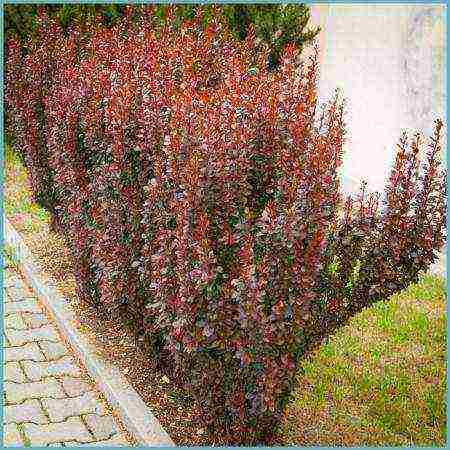
Red Pilar variety
- Golden Ring - the leaf plate of this variety has a coral color with a golden border around the edges. Reaches 3 m in height.

Golden Ring variety
- Aurea - reaches 1.5 m, leaves are golden or yellow.

Aurea variety
- Kobold is a dwarf variety with green leaves. The crown has the shape of a ball. Can replace boxwood. Requires shelter for the winter.

Kobold variety
- Green Carpet - the height of the bush reaches 50 cm. The foliage is green in summer and red in autumn.
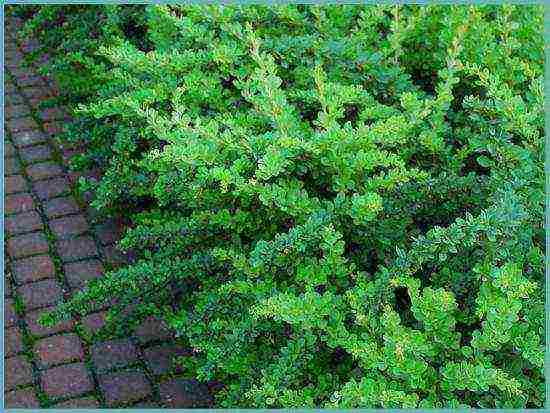
Green Carpet variety
- Kornik - this variety of 1.5 m in height goes well with roses and conifers. The leaves are green in summer with white spots, and in autumn the green color turns red.
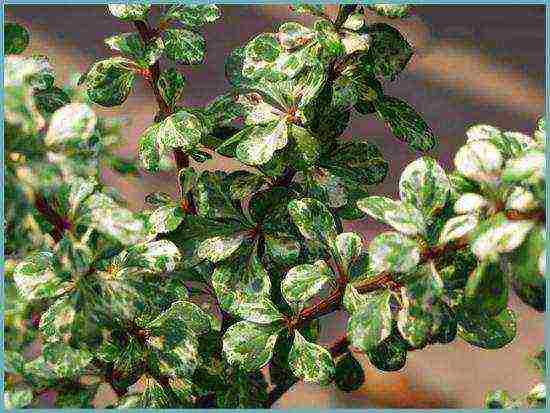
Kornik variety
High varieties, thanks to the thorns, form impassable hedges in the form of ribbons of different lengths. Looks great as a curb, can replace boxwood in cold regions. Suitable for creating a rocky garden and strengthening slopes. Low varieties go well with conifers and perennial flowers.
Landing
Barberry is undemanding to the place of growth. It can grow well in open areas and in partial shade. However, varieties with purple leaves in the shade may lose their decorative effect.
Barberry prefers to grow on soils with neutral acidity; wood ash or lime must be added to the soil with high acidity. The most important thing for barberry is the absence of moisture stagnation.
Barberry is planted in early spring, before bud break. If the bushes will be planted singly, then the distance between them should be from 1.5 to 2 meters. A planting hole for one plant is about 50 x 50 cm and a depth of 35 cm. When laying a hedge, two seedlings are planted per meter. It is better to dig a trench for planting a hedge. To improve the respiration of the root ball, the bottom is sprinkled with sand and the hole is covered with nutritious soil with the addition of humus and wood ash. Watering and compacting the earth.
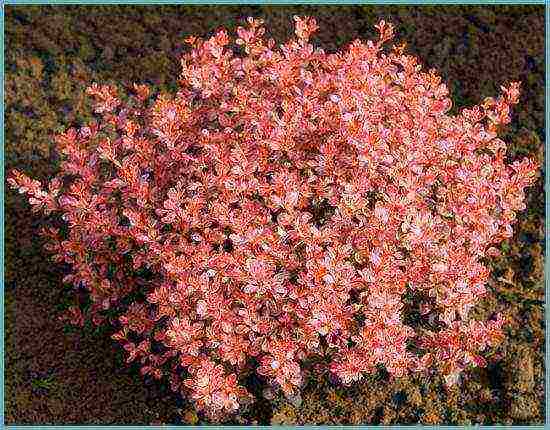
Correct planting is a guarantee of the correct development of the plant
The trunk circle is mulched with humus, foliage or any organic material. In order for the plant to take root well, the aerial part is cut off, leaving 3 - 5 buds. Watering the barberry is necessary at planting and every 10 days until the seedling is accepted.
Barberry seedlings purchased in a container can be planted at any time, except for winter - they take root well, since the root system is not injured.
Advice. Use only fully ripe barberry berries, unripe berries can be poisonous.
Fertilization and feeding
In the first year after planting, you do not need to make any additional fertilizers, the barberry will have enough of those introduced into the planting pit. The next year, in early spring, feed the shrub with a urea solution or any fertilizer with an increased dose of nitrogen. Then fertilized every 4 years:
- in spring - nitrogenous;
- in the fall - phosphorus and potash.
Reproduction of barberry
Barberry is propagated by different methods: seeds, cuttings, layering and dividing the bush. Each of these methods is convenient in its own way, choose the most suitable one.

Barberry seeds
Reproduction by seeds. Select ripe berries, separate the seeds from the pulp, disinfect them in a weak solution of potassium permanganate and dry. Seeds are sown in a school to a depth of 1 cm. In spring, young seedlings are thinned so that a distance of about 3 cm remains between the shoots. Two-year-old seedlings are planted in a permanent place. After a couple of years, young bushes will give the first berries. In order to sow seeds in spring, they must be stratified for a long time at a temperature of 2 to 5 degrees.
Propagation by cuttings... For this method, you will need a greenhouse or a school. Cuttings are harvested in June. It is best to do this in the early morning, before the onset of the heat. The leaves are removed from the cuttings, leaving only on the crown, shortened by half. Put the cuttings in a bucket with root solution for several hours to stimulate root formation. Cuttings are planted in a school in fertile moist soil. The first two weeks carefully monitor the soil moisture and timely ventilation. As with the first method, cuttings are planted in a permanent place after two years.

Adult bushes are easily propagated by layering
Reproduction by layering. In early spring, select the strongest shoot, place it in an earthen groove and pin. The end of the escape must be above the ground. The part that you will drip in can be slightly scratched for faster root formation. In the fall, the finished seedling can be transplanted to a permanent place.
By dividing the bush mainly low-growing varieties of Thunberg barberry are propagated. For this, bushes of 3 - 5 years old are chosen, which branch out from ground level. In early spring, the bush is completely dug up and divided with a saw. Try to injure the root system as little as possible. Treat the sections with a weak solution of manganese or sprinkle with charcoal. Plant the delenki.
Advice. Barberries bear fruit only with cross-pollination. Plant at least two varieties per site.
Agrotechnics and care for barberry
Barberry needs watering only during severe drought in the first years of life. In the future, a strong root system itself is able to provide the plant with water. Watering is carried out under the root with warm water.
Most varieties of Thunberg barberry do not need pruning. Usually this is only sanitary pruning of frozen and thickening shoots, as well as excess growth. Varieties with a loose crown are formed by shortening the protruding shoots. Low-growing varieties do not need to be trimmed at all. To create a hedge, barberry is cut in June and a second time in August.

To give a decorative shape, barberry can be cut
Barberry tolerates frosts very well down to -35 degrees, but in the first winters it is better to cover young bushes with spruce branches or dry leaves for the winter, especially varieties with an evergreen crown.
Advice. The berries of most varieties of Thunberg barberry contain alkaloids, therefore they are bitter and not eaten. But birds willingly eat berries in winter.
Diseases and pests
One of the most dangerous pests of barberry is barberry aphid. The affected leaves of the plant shrivel and dry out. The insect can be seen on the underside of the leaf, the body of the pest is reddish-yellow in color. An increase in the insect colony harms the plant: the leaves curl and fall off, the shoots do not lay flower buds of the next year and are bent. In the spring, spray the barberry with a solution of laundry soap or tobacco infusion.
The flower moth feeds on the fruits of the barberry. Treatment with fufanon or decis will help here.
Fungal diseases are much more dangerous for plant health. It is more difficult to deal with them, and barberry is affected by them more often than by insects.
- Powdery mildew. This disease is caused by a unique fungus that specializes only in barberries. If you notice a whitish bloom on the shoots and leaves at the beginning of summer, this is the mycelium of the fungus, which will ripen by autumn, and will spread even more in spring. It is necessary to spray the plant with a preparation containing sulfur. The leaves are sprayed on both sides. The procedure is carried out twice: at the time of bud break and after flowering. In case of severe damage - additionally again in the fall, after harvest. Shoots that are badly damaged are best removed and burned.
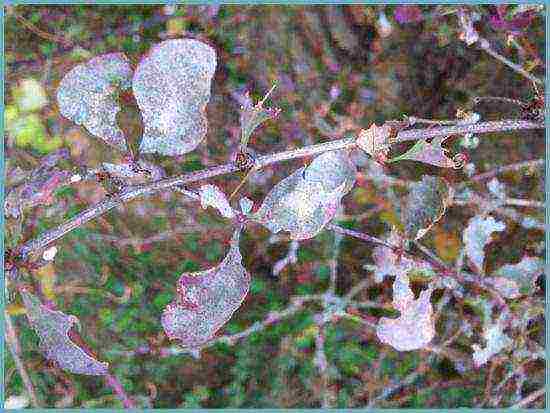
Powdery mildew
- Leaf rust... Thunberg barberry is not affected by this fungus, unlike other barberries.
- Leaf spot - fungal disease. Pathogen spots appear on the leaf plate, which weaken the barberry, the shoots lag behind in development and freeze in winter. Before and after flowering, the plant is sprayed with copper oxychloride.
- Wilting barberry characterized by drying of the branches on one side of the shrub, then the whole plant dries out little by little. On the cut, you can see the brown vessels. The infection enters the plant through the roots.
- Drying of shoots. The fungus infects the bark of the plant and the shoots dry out. This is not a vascular disease.Pruning affected branches in time can prevent further spread of the disease.

Barberry aphid
- Bacteriosis The pathogen from the genus Pseudomonas causes bacterial shoot cancer. Cracks and cancers appear. Bacteriosis does not appear on inflorescences and berries.
Advice. When working with chemicals, do not forget about your own safety and protection of the respiratory system, eyes and skin.
Planting Barberry Thunberg and caring for the shrub will not cause any trouble, but the aesthetic pleasure from its beauty in your garden will exceed all expectations.
Barberry Thunberg in landscape design: video
Barberry Thunberg: photo
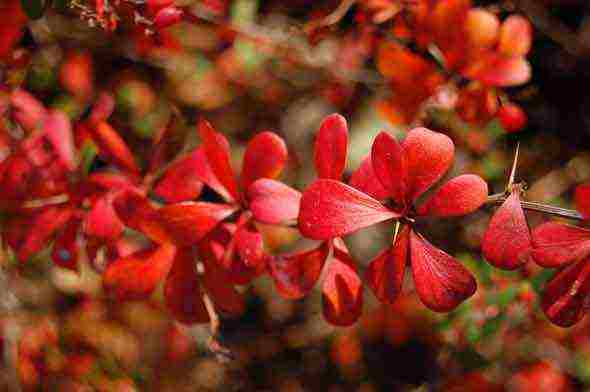
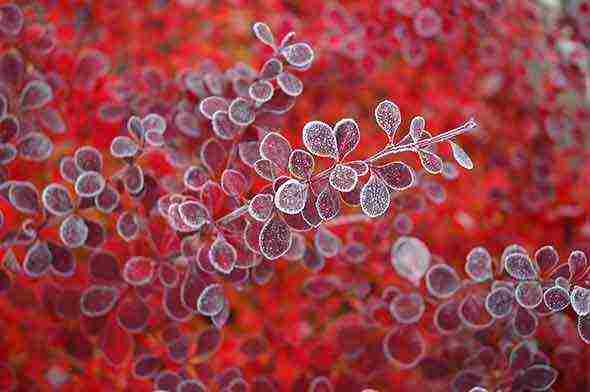
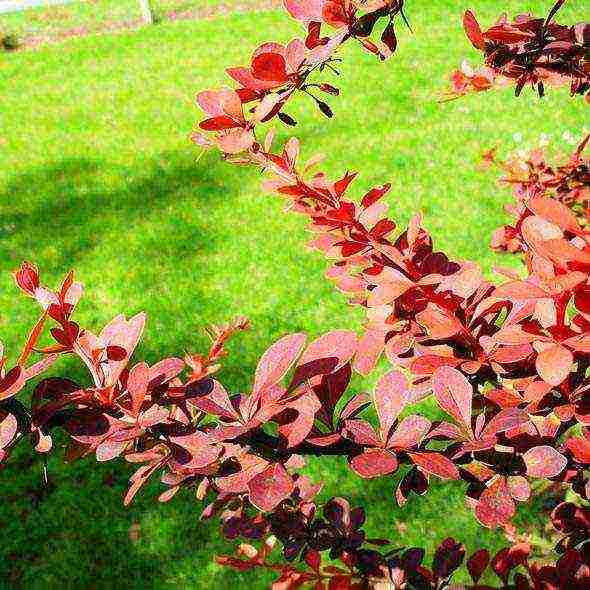
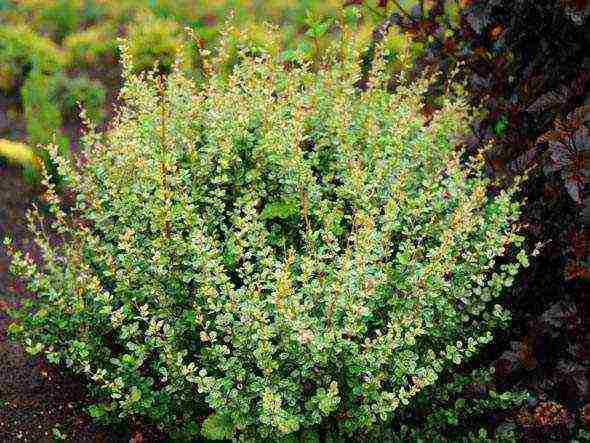

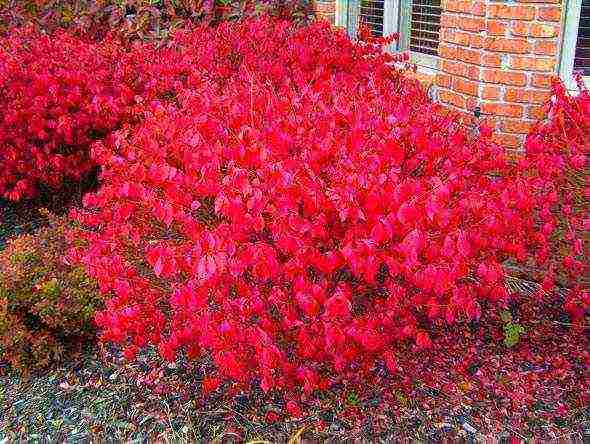
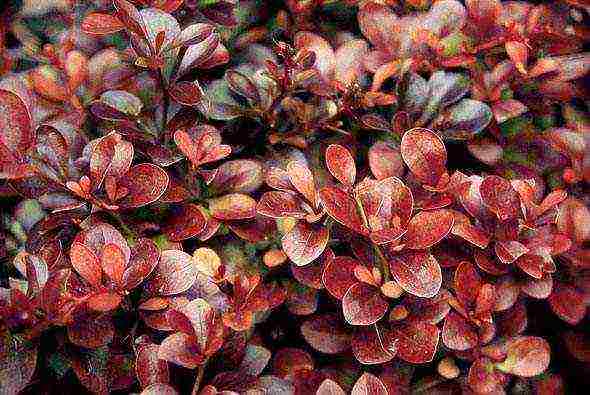
Due to our total employment, gardens of easy care are becoming more and more popular. Is it possible to fill them with beautiful and, at the same time, unpretentious plants? Tunberg barberry Atropurpurea with a dense burgundy crown is ideal for these purposes. Deciduous shrub has a lot of advantages, it looks equally good in curbs, mixborders, rocky compositions, in single and group plantings, hedges.
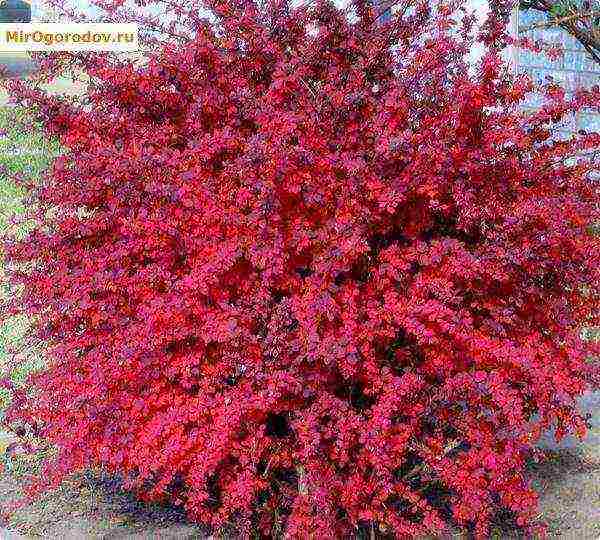
The autumn fire of barberry will fill the empty garden with bright colors
Description and advantages of the variety
The natural habitat of the tunberg barberry is rocky wastelands and mountain slopes under the sultry sun of China and Japan. Extreme conditions hardened the character of the plant, but did not destroy the beauty. The compact, densely leafy shrub has long attracted the attention of breeders and became the ancestor of more than 150 cultivars.
The decorative form of barberry Atropurpurea is attractive and enjoys the attention of gardeners, in the description of which elegant foliage appears - dark purple, burgundy, scarlet-red. In its group, it is the tallest shrub, reaching 1.5–1.8 m in adult form. Its skeletal branches are erect, the lateral shoots are numerous, thin, drooping. It is they who give the crown a spherical shape. The variety grows slowly (20-30 cm per year), simultaneously rising up and spreading out in width.
The shrub blooms at the turn of spring and summer for 2.5 weeks. Discreet graceful yellow flowers are collected in a brush of 2–5 pieces. In autumn and winter, coral berries serve as an additional decoration of the Atropurpurea tunberg barberry; they seem to be strung on snow-covered branches.
A few words about the merits of the Atropurpurea variety.
-
In the first place is decorative appeal. The shrub is good at all seasons. In the spring - with rosettes of fresh, clean foliage and a delicate fragrance of delicate inflorescences; in the summer - with dark purple leaves, in the fall - with a bright crimson dress, in the winter - with red beads of berries on the branches that have flown around.
-
Among the attractive characteristics of the plant are drought resistance, undemanding soil fertility, responsiveness to pruning, minimal maintenance.
-
Although young seedlings of barberry Atropurpurea are less winter-hardy in comparison with other representatives of the species, the plant quickly adapts to climatic conditions. After several years of growth, it easily tolerates rather low winter temperatures.
-
A big plus of the variety is resistance to diseases of a fungal nature - spotting, powdery mildew, rust fungus.
-
The ornamental shrub is versatile for creating landscape compositions. It is combined with conifers, perennials, organic on alpine slides, tapeworms, mixborders.
Among the disadvantages of the variety, they note the need to shelter young plants for the winter and unsuitable fruits for food.
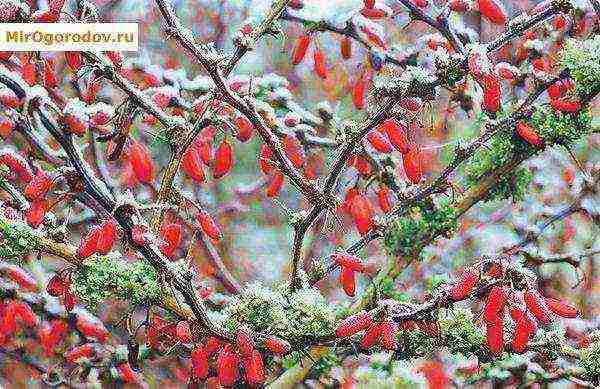
Berries of barberry Atropurpurea, bitter in taste - a favorite winter delicacy of birds
A dwarf variety of the decorative form of Atropurpurea
No less interesting is the dwarf variety of the tunberg barberry - the Atropurpurea Nana variety. Outwardly, it resembles a tall form.The same reddish-brown shoots with sparse thorns, small dense leaves - dark purple inside the crown and brighter on the tops of branches, small bunches of yellow-red flowers, coral fruits.
The main difference is the size and habit of the crown. It is no coincidence that the shrub belongs to the dwarf group. It reaches a maximum height of 0.5–0.6 m and grows into fluffy cushions up to 1 m in diameter.
Note! The plant will grow only 3-4 cm during the year, so it does not need pruning, except for sanitary cleaning. Looks very nice in borders, in the lower tier of mixborders made of conifers and ornamental shrubs.

Dwarf forms of barberry perform a ground cover function, serve as an accent for the greenery of perennials and shrubs
Features of planting and care
In the description of the agrotechnical features of the tunberg barberry Atropurpurea, the requirements for its planting and care, the characteristic is often found - light-loving, shade-tolerant. What does this mean in practice? In order for the variety to fully reveal its potential and show all the splendor of colors, it must be planted in a sunny place protected from northern winds. In partial shade, the plant feels no worse, but the foliage will not be as juicy and bright as in the sun, more dark green than purple.
Advice! Thunberg barberry is afraid not so much of frost as of a cold, scalding wind. Depending on the winter wind rose, it is recommended to plant it from the south and west, under the protection of the walls of the building, dense tall plantings.
Soil, planting nuances
The plant amazes with its unpretentiousness to the soil. The mechanical composition of the soil does not play a big role, the acidity range is wide - pH from 5.5 to 7.5. Only dislikes heavy, moisture-consuming substrates with a tendency for water to stagnate in the root zone.
When planting, it is still recommended to cultivate the soil, that is, add humus, if necessary, loosen it with sand. The quantities are standard for shrubs - 5–8 kg of humus are placed on a hole measuring 50x50x40, the same amount of sand and mixed with garden soil.
The optimal planting time is in the spring before bud break or in the fall during the period of suspension of growth (coincides with leaf fall).
Between the seedlings of tall forms they maintain a distance of 1.5–2 m. The dwarf barberry Atropurpurea Nana, if they want to get a dense border, is planted every 60–80 cm.
Advice! When planting, it is advised to leave the root collar level with the soil. But if you plan to divide the barberry bush in the future, deepen it by 5-7 cm to stimulate the growth of zero shoots.
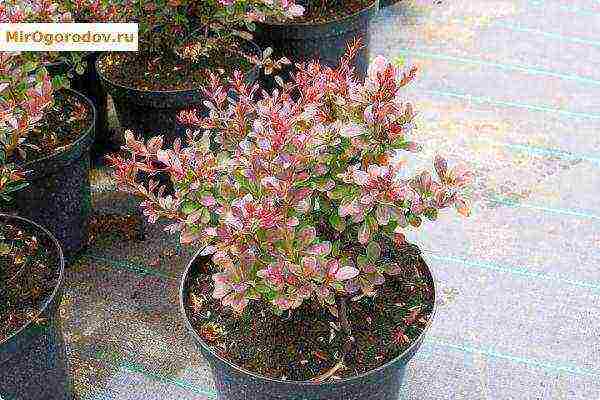
Benefits of closed-root seedlings - they can be planted from spring to autumn
Care during the growing season
Depending on the filling of the hole during planting, they begin to feed the barberry Atropurpurea for 2-3 years. This is done once a year, in the spring. The best fertilizer option - organic matter (humus, compost), which is embedded in the soil, can be watered with a solution of mullein (1:10), poultry droppings (1:20). Mineral alternative - complex fertilizers with nitrogen and microelements for ornamental shrubs, for example, Kemira universal.
Plants need special watering only immediately after planting, while they take root. In the future, rainfall is enough for the shrubs. Rare watering is possible during dry summers. To retain moisture, the trunk circle is mulched with grass or sodden.
Tunberg barberry Atropurpurea lends itself well to a shaping haircut, which is carried out at the beginning of summer and August, but it is not necessary for the normal vegetation of the plant. An obligatory element of care is sanitary pruning in the spring, immediately after bud break. Its function is rather decorative - the removal of old, dry, broken, frost-bruised branches.
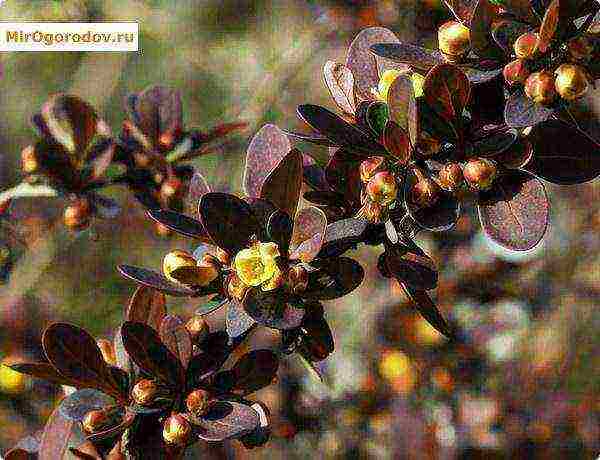
The flowering period is the time for feeding, loosening, mulching the shrub
Preparing for winter
In order for the plant to winter well, the root zone is insulated with a layer of humus.By the way, it will also serve as a spring feeding. Young plants are covered with dry leaves for the first 2–4 years after planting, spruce branches or wrapped in burlap, and a layer of spunbond or lutrasil is thrown on top.
Features of caring for tunberg barberry:
Moscow, Russia, on the site since 11.01.2017
To create an exquisite and attractive landscape, plant bush compositions are justified. The amazingly beautiful Thunberg barberry of the Atropurpurea variety changes the color of the foliage throughout the year and makes the exterior of the site original. A red-purple rounded crown with yellow flowers and oblong fruits will be a bright solitary accent or create a spectacular hedge.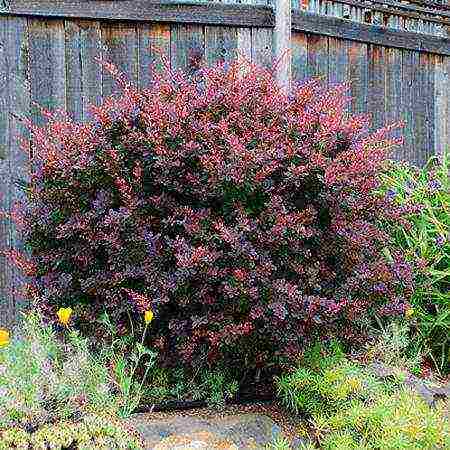
Varietal characteristics
Not only the aesthetic appearance, functionality and originality make the shrub relevant for decorating a country and private house. Sweet and sour, with a slight chill, berries are distinguished by useful properties and are suitable for culinary purposes.
The varietal description demonstrates the following features of the culture:
- unique color of foliage. In sunny areas, the crown plays with purple-violet shades, and in the shade it becomes lighter;
- tall - the plant reaches a height of about 2 m. There is also a dwarf variety - Atropurpurea Nana, which has a semicircular foliage and stretches 60 cm;
- rapid rates of annual growth - 25 cm in height by 35 cm in breadth;
- flat rounded shape of yellow peduncles, collected in inflorescences;
- small leaves 2 to 4 cm long;
- a short period of flower formation - from 10 to 15 days.
The plant looks beautiful in single compositions, groups, and the crown, amenable to shearing, contributes to planting as a molded hedge.
Landing features
The conditions for growing barberry require consideration of its relationship to light, moisture and soil composition. A light-loving culture that is undemanding to the soil composition, it is able to withstand temperature fluctuations in the Russian regions of the middle zone. Planting is performed in open areas, since the decorative effect of the crown is lost in the shade.
How to plant barberry Atropurpurea correctly?
Agronomists recommend purchasing container cuttings adapted to the conditions of the domestic climate. The advantage of ready-made seedlings is the presence of prolonging additives. The culture is grown independently from seeds, cuttings, seedlings, propagated by layering.
To plant a barberry bush, you need to perform the following work:
- Prepare the site in the fall to regulate soil acidity. The area is cleared of debris, dug up and level the soil.
- Liming is carried out by introducing 300-400 g of lime per square meter of land.
- In the spring, when planting, the soil is fertilized with a mixture based on the removed sod layer, mixed with compost and sand in equal proportions of all components.
- Dig a hole, deepened by 45-50 cm, where a shrub with a container lump of earth or a stalk is placed. They control the location of the root collar - it should run along the ground line.
- After planting, the culture is watered by adding up to 10 liters of water per sample. Further watering requires the introduction of 10 liters of water per plant 1 time in 7 days. You need to water the near-trunk circle.
After the landing has been carried out, it is advisable to make a shelter. These types of activities are relevant both for the primary placement in open ground and for transplanting to a new location.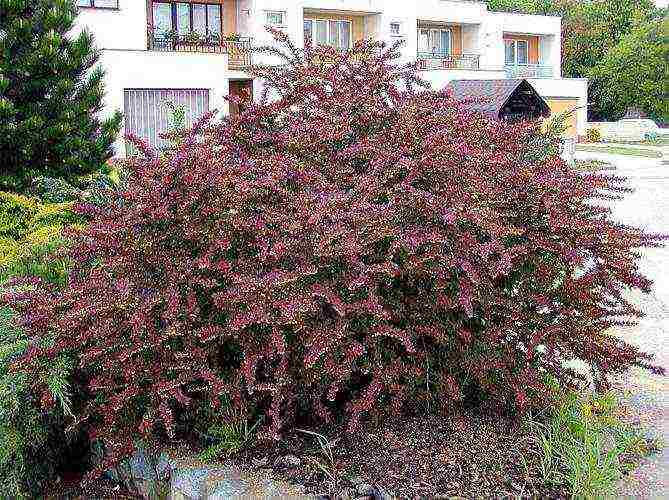
Care rules
The unpretentious barberry of Thunberg Atropurpurea Nana or its tall variety requires proper loosening of the soil, mulching, sanitary and molding pruning. Caring manipulations are performed in parallel to each other.
How to apply top dressing?
Complexes or individual mineral-organic fertilizers are introduced into the soil after the shrub has grown on the site for 2 years.Be sure to make nitrogen fertilizing at the rate of 20-30 g per bush. The fertilizer must be diluted with 10 liters of water and watered with the compound at the trunk. In the future, barberry is fed 1 time in 4 years.
How to loosen and mulch the soil correctly?
The soil is loosened regularly, removing the weed at a depth greater than 3 cm. The soil near the trunk circle is mulched with peat, a mixture of peat and compost, and ash from burnt wood species.
How is pruning done?
Shaping pruning for barberry bushes is carried out in order to maintain a beautiful shape, limit growth and prevent shading of other crops. Measures are necessary when the branches block the view from the windows, reach the electrical wires. Reducing the height of the bush makes the arrangement of the branches of the skeleton uniform, enhances the growth of shoots on the sides, and regulates the rate of fruit formation. Popular shapes for the Atropurpurea variety are ball, oval, cone, or pyramid.
Sanitary pruning is carried out for:
- elimination of branches affected by diseases, prone to interlacing or drying out;
- raising the crown, removing overgrowth;
- creating foliage with uniform light transmission.
During sanitary work, branches are cut that are located at an acute angle or grow vertically.
Rejuvenating pruning will be effective when the bush does not grow, its top dries out. In addition to giving the crown a decorative appearance, pruning promotes good crop growth.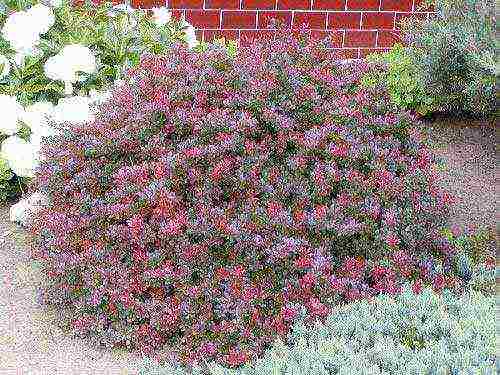
Options for using barberry
Landscape ideas, embodied in their own plot, consist in the active use of compositions from tall and miniature barberries. Florists distinguish several popular forms:
- front garden decor. Several shrubs of Thunberg Atropurpurea are planted as tapered accents or long stripes;
- element of a rock garden or rock garden. Plants growing in open areas look beautiful in a frame of stones, on the slope of a rock garden or an extensive rockery;
- spectacular bowlborder. Shrubs located along the route grid or the walls of the building mask unsightly places, enliven the asceticism of a blank fence. The culture is placed in the middle or near plan;
- beautiful Japanese garden. Thick pillows from the dwarf variety Nana emphasize the elegance and charm of oriental forms. It is important to prune in time so that short shoots create a tillering effect and give the crown density;
- forest edge. The combination of tall deciduous crops and barberry, due to the density of the crown of the latter, has a natural look;
- decoration of a hedge or border. The dense and compact arrangement of branches is ensured by lateral cutting - this is how the flat edges of purple cultivators are formed;
- group compositions. Assemblies with barberry are based on the principles of contrast and are highly visible. It is important to choose the right neighboring breeds - beautiful conifers with pyramid-shaped crowns.
 When choosing a compositional option, take into account the risks of damage to the bush with powdery mildew, rust and carry out preventive spraying with Bordeaux liquid. Control the distance between sequential landings - up to 2 m.
When choosing a compositional option, take into account the risks of damage to the bush with powdery mildew, rust and carry out preventive spraying with Bordeaux liquid. Control the distance between sequential landings - up to 2 m.
Due to its decorativeness, barberry of the Atropurpurea variety is a unique find for landscape design. It is planted not only in compositions, but also complements the coastline of reservoirs.


